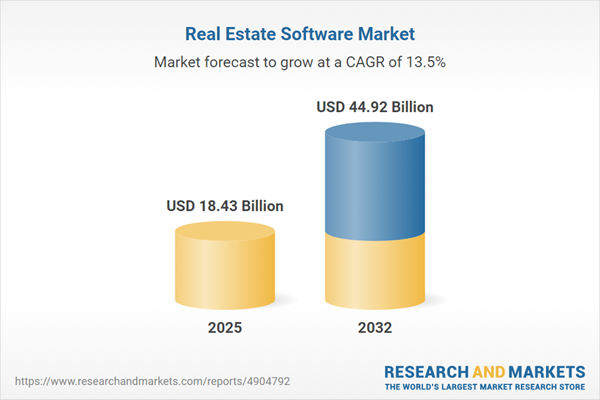Speak directly to the analyst to clarify any post sales queries you may have.
The real estate software market continues to evolve rapidly, with technology adoption transforming operational strategies and delivering measurable value across property management, investment, and leasing. Senior decision-makers are turning to robust software platforms to streamline processes, enhance stakeholder engagement, and gain actionable insights—positioning their organizations for growth in a dynamic competitive landscape.
Market Snapshot: Real Estate Software Market Size and Growth
The Real Estate Software Market grew from USD 16.27 billion in 2024 to USD 18.43 billion in 2025, with expectations to reach USD 44.92 billion by 2032 at a CAGR of 13.53%. This robust expansion is shaped by digital transformation, increasing demand for automation, and advanced analytics capabilities. Senior leaders are leveraging these solutions to optimize decision-making, improve operational transparency, and respond to evolving market demands with agility.
Scope & Segmentation: Key Segments and Technology Focus
- Application Types: Analytics & Reporting (Performance Analytics, Predictive Analytics), Collaboration (Communication Tools, Document Management), Financial Management (Accounting, Budgeting), Lease Management (Lease Administration, Tenant Management), Property Management (Commercial, Residential), Sales Management (Commercial Sales, Residential Sales)
- Deployment Models: Cloud-Based (Private Cloud, Public Cloud), Hybrid, On-Premise (Licensed Deployment, Subscription Deployment)
- End Users: Facility Managers (Corporate, Third-Party), Landlords & Owners (Individual Investors, Institutional Owners), Property Managers (Commercial, Residential), Real Estate Agents (Commercial Brokers, Residential Brokers), Organization Size (Tier 1 and Tier 2 Large Enterprises, Medium Enterprises, Small Enterprises)
- Regional Coverage: Americas (United States, Canada, Mexico, Brazil, Argentina, Chile, Colombia, Peru), Europe, Middle East & Africa (United Kingdom, Germany, France, Russia, Italy, Spain, Netherlands, Sweden, Poland, Switzerland, UAE, Saudi Arabia, Qatar, Turkey, Israel, South Africa, Nigeria, Egypt, Kenya), Asia-Pacific (China, India, Japan, Australia, South Korea, Indonesia, Thailand, Malaysia, Singapore, Taiwan)
- Technological Advancements: Cloud computing, artificial intelligence, mobile-first design, advanced encryption, IoT integration, geospatial mapping, ESG and sustainability tracking
- Key Companies: Zillow Group, CoStar Group, CoreLogic, Black Knight, Procore Technologies, AppFolio, Yardi Systems, Buildium, MRI Software, SmartRent
Key Takeaways: Strategic Insights for Leadership
- Adoption of cloud-native real estate software platforms is accelerating as organizations seek scalability, streamlined updates, and flexible cost structures.
- AI-powered predictive analytics and machine learning are increasingly integrated into property management, enabling proactive maintenance and improved asset performance.
- ESG and sustainability requirements are guiding software development, with enhanced reporting tools and carbon tracking capabilities gaining traction among corporate clients.
- Mobile-first interfaces, IoT-powered devices, and geospatial tools are becoming critical for real-time operations, supporting field teams and facility managers on-site.
- Strategic partnerships, API ecosystems, and modular platforms are redefining industry competition, as companies expand functional coverage and enhance interoperability.
Tariff Impact: Navigating Geopolitical and Cost Factors
The introduction of new United States tariffs on imported hardware and software components is influencing vendor strategies and supply chain resilience in 2025. Companies reliant on specialized equipment are reevaluating sourcing, pricing, and volume agreements to safeguard margins. The upward pressure on the cost of on-premise deployments is motivating a shift toward cloud-based solutions, fundamentally altering total cost of ownership calculations and intensifying competitive dynamics in cloud service provision. Regional hosting and strategic collaborations are also gaining prominence as organizations aim to comply with jurisdictional regulations and mitigate tariff exposure.
Methodology & Data Sources
This report is built on rigorous primary and secondary research, including interviews with industry executives, product managers, and technology leaders. Data sourcing encompasses industry white papers, regulatory materials, vendor collateral, and public financial disclosures. Validation procedures such as consistency checks and benchmarking ensure accuracy and actionable insights.
Why This Report Matters: Outcome-Driven Value for Decision Makers
- Provides in-depth, granular segmentation to support tailored software selection and deployment strategies across diverse property portfolios and markets.
- Delivers actionable intelligence on regulatory shifts, technological disruption, and innovation trends, empowering strategic planning and risk management.
By focusing on the real needs of senior leaders, this report enables proactive investment, operational resilience, and sustainable growth in the evolving real estate software sector.
Conclusion
For senior decision-makers, leveraging real estate software is essential to navigating transformation and maintaining a competitive edge. This report equips organizations with the intelligence needed for effective strategy, innovation, and operational excellence in today’s marketplace.
Additional Product Information:
- Purchase of this report includes 1 year online access with quarterly updates.
- This report can be updated on request. Please contact our Customer Experience team using the Ask a Question widget on our website.
Table of Contents
3. Executive Summary
4. Market Overview
7. Cumulative Impact of Artificial Intelligence 2025
Companies Mentioned
The companies profiled in this Real Estate Software market report include:- Zillow Group, Inc.
- CoStar Group, Inc.
- CoreLogic, Inc.
- Black Knight, Inc.
- Procore Technologies, Inc.
- AppFolio, Inc.
- Yardi Systems
- Buildium
- MRI Software
- SmartRent
Table Information
| Report Attribute | Details |
|---|---|
| No. of Pages | 188 |
| Published | October 2025 |
| Forecast Period | 2025 - 2032 |
| Estimated Market Value ( USD | $ 18.43 Billion |
| Forecasted Market Value ( USD | $ 44.92 Billion |
| Compound Annual Growth Rate | 13.5% |
| Regions Covered | Global |
| No. of Companies Mentioned | 11 |









